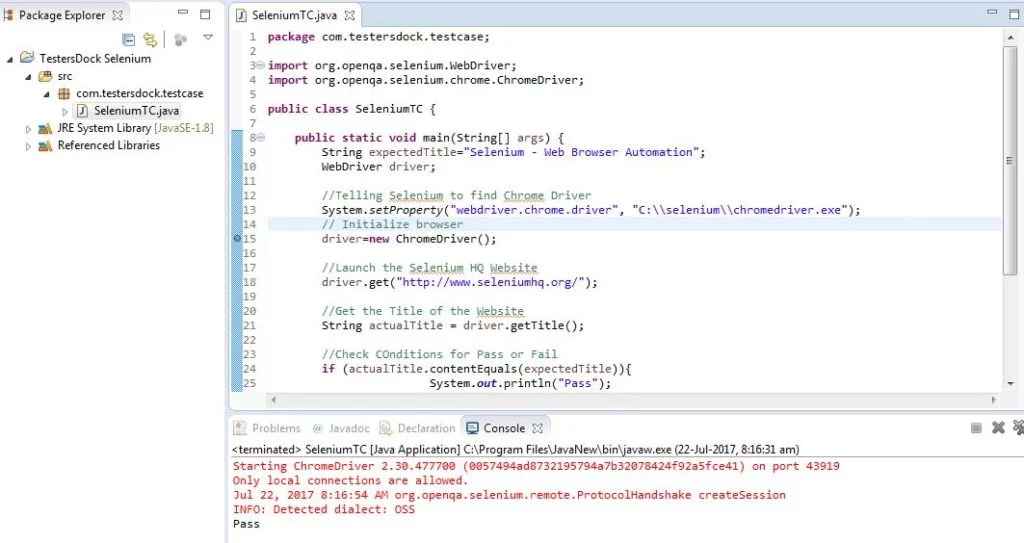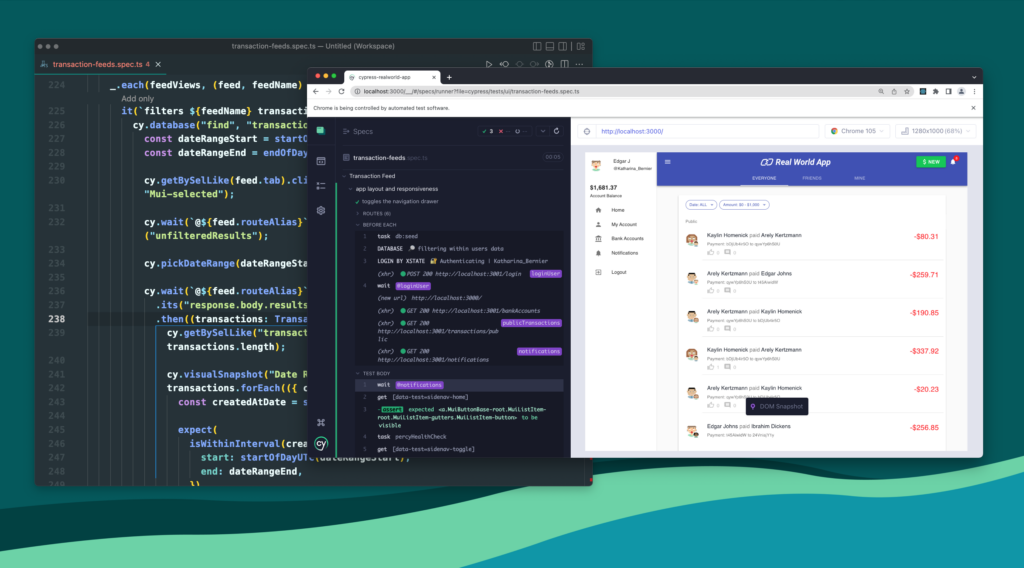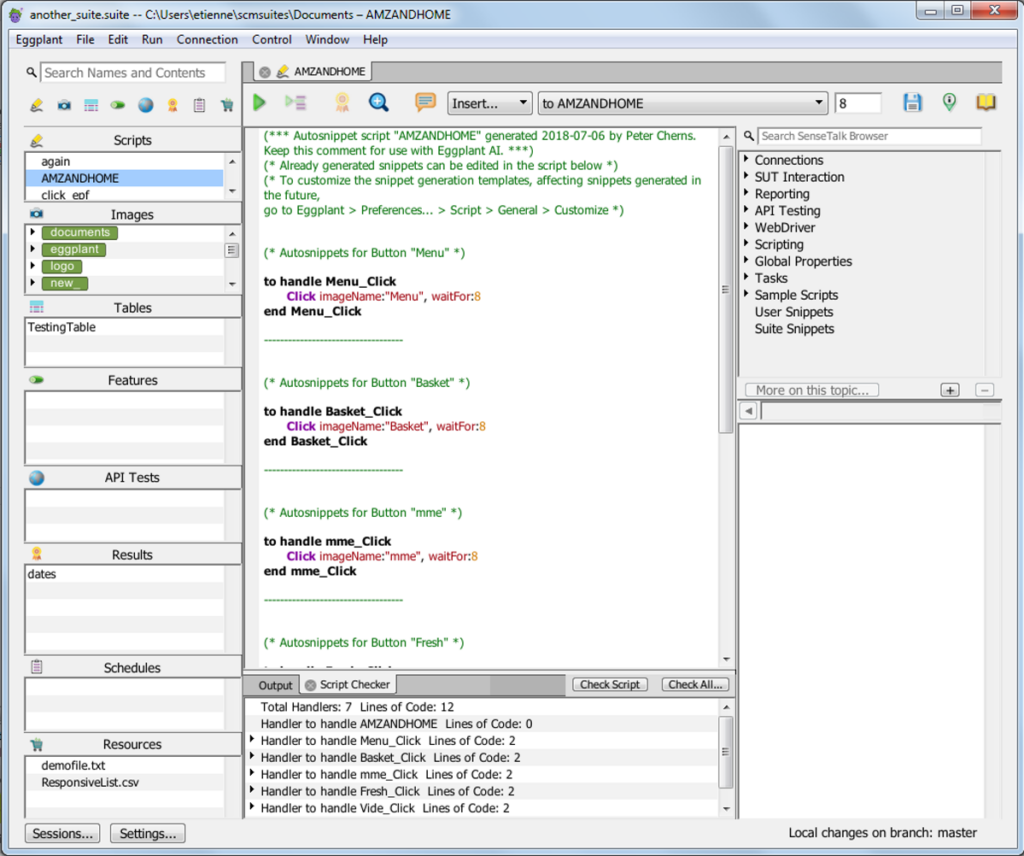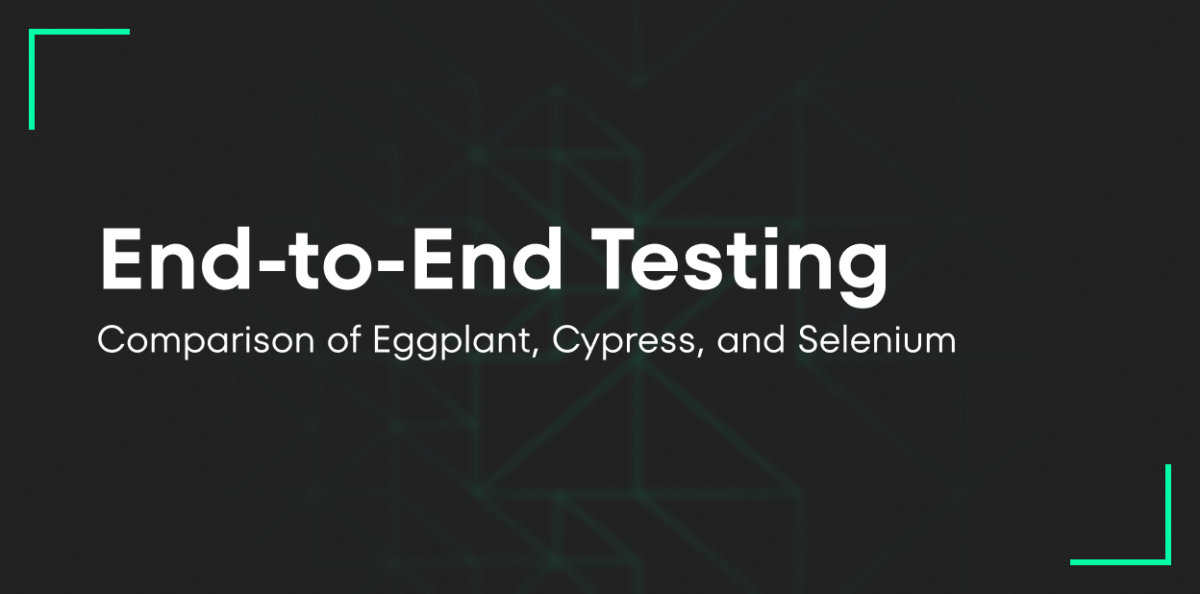Working as a software tester, I have noticed how end-to-end (E2E) testing plays a key role in the whole software development process. This type of testing is crucial in ensuring the quality and reliability of the final products. It is through E2E testing that we can identify potential component integration issues and verify that the entire application is working as expected by the user. My experience shows that E2E testing is not only a verification process, but also a tool to simulate real-life usage scenarios. Focused on a comprehensive analysis of user paths, they enable us to identify possible problems at different stages of the user’s interaction with the application.
There are many tools for automating E2E testing. In the article below, I compare the three leading ones: Cypress, Selenium and Eggplant in terms of features, application and cost. Each of these tools presents a unique approach to test automation, with different benefits and challenges. My goal for this article is to provide a fuller perspective on the issues of selecting a tool for the specifics of a project, so that the decision can be made in the right way.
Using practical examples of identifying elements on a website or in a desktop application, I will describe how the three platforms perform in real-world testing situations. I will point out both the advantages and disadvantages of each depending on the context. I hope this article will serve as a practical resource, and help E2E testing professionals to understand the capabilities and limitations of each tool fully.
E2E Testing Tools
In the world of software testing, automation tools play a key role in ensuring test efficiency and repeatability. Three popular tools – Selenium, Cypress, and Eggplant – offer different approaches to test automation, providing developers and testers with effective ways to ensure software quality.
Selenium
Selenium is a powerful tool for automating web application testing. Its working principle is based on remote browser control, allowing developers to emulate user interactions. Selenium supports a range of programming languages, such as Java, Python, C#, Ruby, JavaScript, allowing teams to use their preferred technologies. Selenium tests are typically scripted in one of these languages, allowing for flexibility to adapt to different projects.
Pros
- Support for multiple programming languages: Selenium allows you to write tests in popular languages such as Java, Python, C#.
- Cross-browser support: It is compatible with multiple browsers, allowing you to test on different platforms.
- Rich community and documentation: Selenium’s large community and extensive documentation make troubleshooting easy. Selenium has been on the market since 2004. Since then, it has become one of the most widely used tools in the field of software testing.
Cons
- Slower test execution: Communication with the browser can slow down the testing process. Test commands are sent over the network, which introduces delays in translating, transmitting and receiving instructions, and this can slow down the testing process compared to tools that run directly inside the browser, such as Cypress. However, optimization and configuration adjustments can help minimize this impact.
- The need for manual configuration: Installing and configuring various components can be time-consuming. The need for manual configuration in Selenium can be time-consuming due to various components, such as installing and updating browser drivers, managing dependencies, configuring the environment, supporting mobile browsers, integrating with testing tools, and adjusting security settings. All of these require diligence and manual intervention, which can lead to a lengthy configuration process.
When to use?
Selenium is widely used to test web applications, but it can also be adapted to test desktop applications with the right tools. Below I present some such tools:
- WinAppDriver
- Description: WinAppDriver is a tool created by Microsoft that allows you to test Windows applications using Selenium WebDriver.
- Use with Selenium: WinAppDriver can be integrated with Selenium to test desktop applications on the Windows platform
- Appium:
- Description: Appium is an open-source test automation tool that supports the testing of mobile and desktop applications on various platforms.
- Use with Selenium: Appium provides functionality for testing desktop applications on Windows, macOS, and Linux platforms, which enables integration with Selenium.
- SikuliX
- Description: SikuliX is a tool for automating user interface interactions using images. It allows you to recognize and interact with user interface elements based on their appearance.
- Use with Selenium: SikuliX can be integrated with Selenium to handle user interface elements in desktop applications that are difficult to identify with traditional selectors.
- AutoIt
- Description: AutoIt is a scripting language for automating tasks in Windows. It allows you to simulate interactions with the keyboard, mouse, and system windows.
- Use with Selenium: AutoIt can be used with Selenium to handle interactions with system windows when testing desktop applications on the Windows platform.
- Robot Framework
- Description: Robot Framework is a test automation tool that offers support for testing different types of applications, including desktop applications.
- Use with Selenium: Robot Framework can be used with SeleniumLibrary to test both web and desktop applications.
Integration of Selenium with the mentioned tools allows flexible testing of different types of applications, increasing the scope of test automation in a desktop environment. However, it is worth noting that the effectiveness depends on the specific use case and requirements of the applications under test.
Cypress
Cypress is a state-of-the-art tool focused on testing web applications, offering direct control over the browser. The principle of Cypress is based on running tests inside the browser, which allows quick access to browser functions. Test scripts in Cypress are written in JavaScript, which makes the tool attractive to developers who want to integrate tests into their application code.
Pros
- Speed of test execution: Runs directly in the browser, eliminating the need for remote communication and speeding up the testing process.
- Simple syntax and ease of setup: Cypress offers a clear syntax, making it easy to write tests even for beginners.
- Automatic page reload: Cypress automatically reloads the page after every code change, making it easy to iteratively write tests.
- Automatic screenshots and videos of test execution and the ability to test components/parts of the application.
Cons
- Limited browser support: Optimized mainly for Chrome, which can be a problem for projects that require cross-browser testing.
- Lack of support for desktop applications: Cypress is focused on testing web applications, which can be a limitation for desktop projects.
When to use?
- Cypress is ideal for testing web applications, but is not dedicated to testing desktop applications.
- Testing web applications from CI with a browser running in headless mode.
Eggplant
Eggplant is distinguished by its approach based on image analysis. The principle of the tool is to emulate user interaction by comparing expected images with actual interaction results. Eggplant works with a variety of programming languages, such as Java, Python, and Ruby, allowing test teams to tailor the tool to project preferences.
Pros
- Artificial intelligence: Eggplant uses artificial intelligence to automatically generate and maintain tests, which can speed up the testing process.
- Cross-platform support: Eggplant allows testing of both web and desktop applications, including mobile.
- Performance testing: Eggplant allows you to test application functionality, performance, and stability.
Cons
- Complicated configuration: May require more advanced configuration compared to other tools. Eggplant’s configuration may include fine-tuning image scripts for GUI changes, configuring access to individual interface components, customizing image analysis parameters, and integrating with other tools. While this advanced configuration can be challenging, Eggplant offers advanced testing capabilities based on image analysis, which can be beneficial in some projects. For some users, especially those who prefer a traditional testing approach, the complex configuration may be considered a drawback.
- Smaller community: It has a smaller community compared to Selenium, which may affect the availability of support.
- Lack of a free version.
When to use?
- Eggplant applies to both web, desktop and mobile application testing.
- Testing enterprise-class applications with a huge number of test scenarios
Conclusion
The choice of a test automation tool depends on the characteristics of the project, the skills of the team and the type of testing required. Understanding the operating principles and testing languages for Selenium, Cypress and Eggplant helps testers tailor tools to specific requirements and achieve effective test automation.
User interface comparison
Selenium

Interface Characteristics:
- Code script-based interface.
- Tools for creating and managing tests in different programming languages.
- Interoperability with different programming environments.
Benefits
- Universality with support for multiple programming languages.
- Integrated developer tools for experienced programmers.
Disadvantages
- Can be difficult for those without programming experience.
- More steps in test setup.
Cypress

Interface Characteristics
- Simple and clear user interface.
- Tree view for easy test navigation.
- Built-in debugging and test analysis tools.
Benefits
- Ease of use, making it easy to bring new people into the project.
- Focus on transparency and simplicity.
Disadvantages
- No advanced graphics tools, which may be a limitation for advanced users.
Eggplant

Interface Characteristics
- Complex and advanced interface.
- Use of graphical representation of test scenarios.
- A large number of configuration options and settings.
- Intuitive tools for analyzing test results.
Benefits
- Ability to handle complex scenarios with graphical tools.
- Full visibility and control over test parameters.
Disadvantages
- Higher learning threshold due to the complexity of the interface.
- May require more time to get used to the tool.
Conclusion
In summary, each of these tools has its unique interface, and the choice depends on the team’s preference, experience level, and project specifics. Eggplant offers advanced graphical tools, Cypress focuses on simplicity and transparency, and Selenium is based on code scripting, which offers great programming possibilities.
Feature Comparison
Support for Programming Languages:
- Selenium supports Java, Python, C#.
- Cypress supports JavaScript.
- Eggplant has support for multiple languages, but customization to the specifics of the tool is necessary.
Browsers:
- Selenium supports a variety of browsers.
- Cypress is mainly optimized for Chrome.
- Eggplant allows testing on different platforms, but requires configuration.
Test Execution Speed:
- Cypress offers speed due to running directly in the browser.
- Selenium can be slower due to its communication with the browser.
- Eggplant can be efficient due to its use of artificial intelligence.
Application:
- Selenium: Widely used for web and desktop applications.
- Cypress: Ideal for testing web applications.
- Eggplant: Versatile application for different platforms.
Price
Cost
- Selenium: Free (Open Source).
- Cypress: Free (Open Source).
- Eggplant: Paid, requires the purchase of a license.
Examples
Here are examples of End-to-End (E2E) testing with code in Cypress, Selenium and Eggplant tools, where each tool will check the same thing:
User login
Selenium
# Selenium test dla logowania użytkownika
from selenium import webdriver
driver = webdriver.Chrome()
driver.get('https://example.com/login')
username_field = driver.find_element_by_id('username')
password_field = driver.find_element_by_id('password')
login_button = driver.find_element_by_id('login-button')
username_field.send_keys('moj_login')
password_field.send_keys('moje_haslo')
login_button.click()
assert '/dashboard' in driver.current_url
driver.quit()
Cypress
// Cypress test dla logowania użytkownika
it('Logowanie użytkownika', () => {
cy.visit('/login');
cy.get('#username').type('moj_login');
cy.get('#password').type('moje_haslo');
cy.get('form').submit();
cy.url().should('include', '/dashboard');
});
Eggplant
Skrypt w Eggplant Functional Script: -- Skrypt Eggplant dla logowania użytkownika z obszarem wyszukiwania params loginData Scenario Outline "Testowanie logowania z różnymi danymi" Given "Moja aplikacja jest otwarta" When "Wpisuję dane logowania: <loginData>" And "Klikam przycisk Zaloguj" Then "Sprawdzam, czy jestem przekierowany do panelu nawigacyjnego" Examples: | loginData | | ["moj_login", "moje_haslo"] | | ["inny_login", "inny_haslo"] | | ["kolejny_login", "kolejne_haslo"] | function TestowanieObszaruWyszukiwania (searchData) put searchData[2] into SearchField -- Przykładowe dane do wyszukania typeText SearchField click "SearchButton" end TestowanieObszaruWyszukiwania
In Eggplant, the use of scenario outline allows parameterization of tests and testing of different data sets. In addition, the Search Rectangle testing feature uses a search area (Search Rectangle) to test search functions dynamically. This approach allows for more flexible and scalable testing when the user interface changes.
Form submission
Selenium
Python:
# Test Selenium dla przesyłania formularza
from selenium import webdriver
driver = webdriver.Chrome()
driver.get('https://przyklad.com/formularz')
pole_imienia = driver.find_element_by_id('imie')
pole_email = driver.find_element_by_id('email')
pole_wiadomosci = driver.find_element_by_id('wiadomosc')
przycisk_submit = driver.find_element_by_id('przeslij')
pole_imienia.send_keys('Jan Kowalski')
pole_email.send_keys('jan.kowalski@przyklad.com')
pole_wiadomosci.send_keys('To jest testowa wiadomość.')
przycisk_submit.click()
assert '/potwierdzenie' in driver.current_url
# Dodaj testy dla obszaru wyszukiwania, jeśli dostępne
driver.quit()
Cypress
// Test Cypress dla przesyłania formularza
it('Przesyłanie Formularza', () => {
cy.visit('/formularz');
cy.get('#imie').type('Jan Kowalski');
cy.get('#email').type('jan.kowalski@przyklad.com');
cy.get('#wiadomosc').type('To jest testowa wiadomość.');
cy.get('form').submit();
cy.url().should('include', '/potwierdzenie');
// Dodaj testy dla obszaru wyszukiwania, jeśli dostępne
});
Eggplant
Skrypt w Eggplant Functional Script: -- Skrypt Eggplant dla przesyłania formularza z obszarem wyszukiwania params daneFormularza Scenario Outline "Testowanie przesyłania formularza z różnymi danymi" Given "Moja aplikacja jest otwarta" When "Wpisuję dane formularza: <daneFormularza>" And "Klikam przycisk Wyślij" Then "Sprawdzam, czy jestem przekierowany do strony potwierdzenia" Examples: | daneFormularza | | ["Jan Kowalski", "jan.kowalski@przyklad.com", "To jest testowa wiadomość."] | | ["Anna Nowak", "anna.nowak@przyklad.com", "Inna testowa wiadomość."] | | ["Adam Nowicki", "adam.nowicki@przyklad.com", "Kolejna testowa wiadomość."] | function TestowanieObszaruWyszukiwania (daneWyszukiwania) put daneWyszukiwania[3] into SearchField -- Przykładowe dane do wyszukania typeText SearchField click "PrzyciskWyszukaj" end TestowanieObszaruWyszukiwania
In these examples, each tool tests the same form submission scenario, and the Eggplant script includes a scenario (scenario outline) to test different sets of form data.
Summary
Now that we’ve thoroughly explored the field of end-to-end (E2E) testing and compared three key tools – Cypress, Selenium, and Eggplant – it’s time to summarize our testing journey.
Performing E2E testing is a fundamental part of the software testing process, enabling the identification of potential component integration issues and ensuring that the entire application works as expected by the user. E2E testing is not only a verification tool but also an effective means to simulate real-world usage scenarios, which translates into effective analysis of user paths.
Comparing the tools, I noticed that Cypress, Selenium, and Eggplant have their unique features, providing different benefits and challenges:
- Cypress stands out for its simplicity and speed, ideal especially for smaller projects.
- Selenium, with its huge community and support for multiple programming languages, is a solid choice for projects of varying scales.
- Eggplant, on the other hand, with its artificial intelligence, is capable of handling more advanced testing scenarios in large organizations.
It’s also worth noting that Selenium and Cypress are more focused on testing web applications, while Eggplant offers support for a variety of platforms, including desktop and mobile applications.
Hopefully, this article will help all E2E testing professionals to make more informed decisions about choosing the optimal tool. The ultimate goal is to streamline the testing process, tailored to the specific challenges we encounter in the day-to-day execution of our jobs.
